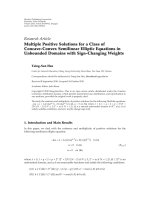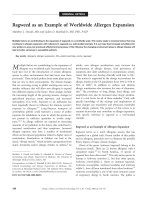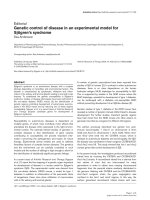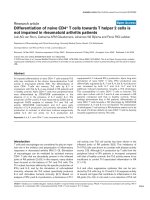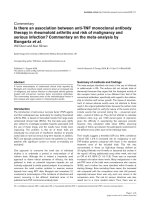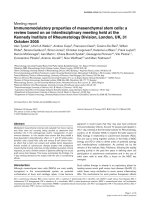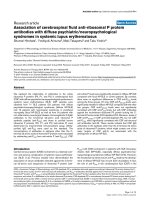Báo cáo y học: "Snow Control - An RCT protocol for a web-based self-help therapy to reduce cocaine consumption in problematic cocaine users" pps
Bạn đang xem bản rút gọn của tài liệu. Xem và tải ngay bản đầy đủ của tài liệu tại đây (291.56 KB, 7 trang )
STUD Y PRO T O C O L Open Access
Snow Control - An RCT protocol for a web-based
self-help therapy to reduce cocaine consumption
in problematic cocaine users
Michael Schaub
1*
, Robin Sullivan
1
and Lars Stark
2
Abstract
Background: Cocaine use has increased in most European countries, including Switzerland, and many states
worldwide. The international liter ature has described treatment models that target the general population. In
addition to supplying informative measures at the level of primary and secondary prevention, the literature also
offers web-based self-help tools for problematic substance users, which is in line with tertiary prevention. Such
programs, however, have been primarily tested on individuals with problematic alcohol and cannabis consumption,
but not on cocaine-dependent individuals.
Methods/Design: This paper presents the protocol of a randomised clinical trial to test the effectiveness of a web-
based self-help therapy to reduce cocaine use in problematic cocaine users. The primary outcome is severity of
cocaine dependence. Secondary outcome measures include cocaine craving, consumption of cocaine and other
substances of abuse in the past month, and changes in depression characteristics. The therapy group will receive a
6-week self-help therapy to reduce coca ine consumption based on methods of Cognitive Behavioural Therapy,
principles of Motivational Interviewing and self-control practices. The control group will be presented weekly
psycho-educative information with a quiz. The predictive validity of participant characteristics on treatment
retention and outcome will be explored.
Discussion: To the best of our knowledge, this will be the first randomised clinical trial to test the effectiveness of
online self-help therapy to reduce or abstain from cocaine use. It will also investigate predictors of outcome and
retention. This trial is registered at Current Controlled Trials and is traceable as NTR-ISRCTN93702927.
Background
Although data on the prevalence of problematic cocaine
use and addiction are lacking in Switzerland and many
other developed countries, ther e is no doubt that, in
line with other countries, cocaine use has increased in
Switzerland in r ecent years [1,2]. Over the past ten
years, the number of cocaine-related disorder treat-
ments has quintupled in outpatient treatment and advi-
sory services [2]. In 2005, resident institutions reported
that, for the first time in history, cocaine outstripped
opiates as the main substance used [3]. This trend has
also been observed in outpatient units [3]. Further evi-
dence of increased cocaine consumption has been
found by quantifying cocaine concentrations in sewage
effluents [4] and in recent HBSC student surveys [5].
The abovementioned increase in treatment requests likely
reflects only a minority of cocaine users. Presumably, the
majority of users consume cocaine on a quasi-controlled
basis, whereas only a small fraction of consumers is likely
to take advantage of available treatments [6]. However, it
is expected that some users will switch from controlled to
problematic use [7]. For those users, interventions that
follow the principle of concurrent cover (i.e., non-invasive,
low-cost interventions in whic h therapeutic intensity can
be enhanced according to need) appear appropriate.
In recent times, the international literature has
described treatment models that target the general
population. In addition to supplying informative mea-
sures a t the level of primary and secondary prevention,
the literature also offers web-based self-help tools for
* Correspondence:
1
Research Institute for Public Health and Addiction, Zurich, Switzerland
Full list of author information is available at the end of the article
Schaub et al. BMC Psychiatry 2011, 11:153
/>© 2011 Schau b e t al; licensee BioMed Central Ltd. This is an Open Access article distribute d under the terms of the Creat ive Co mmons
Attribution License ( which permits unrestricted use, distribution, and reproduction in
any medium, provided the origin al work is properly cited.
problematic substance users, which is in line with ter-
tiary prevention [8-10].
Web-based self-help programs that reduce problematic
consumption are able to reach “hidden” consumer groups
in the general population due to their low treatment
threshold and non-restrictive setting for intervention
[11]. Furthermore, these programs show a remarkably
positive cost-benef it relation [12], which is of interest in
Switzerland and other industrialised countries suffering
from exorbitant health costs. Such programs, however,
have been pr imarily tested on individuals with pr oble-
matic alcohol and cannabis consumption but not on
cocaine-dependent individuals [9,10,13].
Therefore, Snow Control, a six-week self-help therapy
for problematic cocaine users who intend to reduce or
stop consuming and have access to the Internet was
developed in 2010. Snow Control is based on me thods of
Cognitive Behavioural Therapy (CBT) that have been
tested on cocaine addicts [14,15], principles of Motiva-
tional Interviewing [16], current self-control practices
and the established Relapse-Prevention Model [17-19].
The therapy is structured into three parts and includes
the following eight modules that are activated for access
week by week (modules 1 to 4) and four additional volun-
tary modules (module 5 to 8) that can be activated during
week 4-6:
• Part 1: Introduction
○ Registration process
○ Explanation of t he cocaine consumption d iary
and its fully automated progress charts and
statistics
○ Examination of the pros and cons resulting
from a change in cocaine co nsumption patterns
to address motivation
○ Explanation of the “My Snow Control” folder
(This folder allows individuals to review the
acquired summarised module documents, e.g.,
the list of the top five strategies for dealing with
cocaine cravings)
• Part 2: Key Modules (to be worked through in the
following order)
○ Module 1: Strategies for goal achievement
○ Module 2: Identifying risk situations
○ Module 3: Dealing with cocaine craving
○ Module 4: Dealing with relapses
• Part 3: Further Modules (to b e worked through in
optional order but with the recommendation to
complete at least two)
○ Module 5: Enjoying leisure time
○ Module 6: Dealing with burdens
○ Module 7: Saying “no” to foster refusal skills
○ Module 8: Preserving achievements
After the completion of part 1, each login in the therapy
group will direct the participant to the consumption diary.
The participants are asked to determine the amount of
cocaine they plan to consume in the next 7 days and to
specify the amount of cocaine consumed in the p ast 7
days into their consumption diary. After the completion of
the consumption diary, they are directed to their weekly
module (part 2 to be worked through in the above men-
tioned order; part 3 to be worked through in an optional
order).
To assess the effectiveness of the Snow Control therapy,
an appropriate psycho-educative online control condition
was developed. Participants in the control condition
receive eight psycho-educative information modules on
the risks, potential harms and other important information
about cocaine consumption. The frequency of the control
condition is comparable to the 6 weeks of intervention;
however, it does not include the presentation of a con-
sumption diary first. After having read each of the infor-
mation modules, the participants are invited to participate
in a weekly quiz to evaluate their information knowledge.
Methods/Design
Aims of the trial
This study aims to test the effectiveness of the web-based
cognitive-behavioural self-help therapy Snow Control to
reduce cocaine use in problematic cocaine users in a two-
arm randomised controlled trial. The primary ou tcome is
the change in severity of cocaine dependence between
baseline, 3 and 6 weeks of therapy/intervention and at a
6-month follow up. The secondary outcome measures
include changes in cocaine craving, the past month’s con-
sumption of cocaine and other substances of abuse and
changes in depression characteristics. The predictive valid-
ity of participant characteristics for treatment retention
and outcome will be explored.
Study population
The study population will be recruited through the Sn ow
Control website, several websites from local outpatient
treatment centres and from nightlife prevention websites.
In addition, advertisements in Internet-forums and news-
papers will be traced.
Hypotheses
We hypothesise that Snow Control participants in the
therapy group will show higher reductions on the Sever-
ity of Dependence S cale (SDS) [20] sum score and
cocaine consumption than those in the control group at
the 6-week treatment termination and at the 6-month
follow up. Moreover, we expect participants in the ther-
apy group to improve more significantly with respect to
the secondary outcomes between baseline and 6-week
Schaub et al. BMC Psychiatry 2011, 11:153
/>Page 2 of 7
treatment termination. We also expect the participants in
the therapy group to show significantly higher retention.
Measurement instruments
The primary outcome instrument, the Severity of Depen-
dence Scale (SDS), is a 5-item questionnaire that indicates
the severity of dependence on cocaine. Each of the five
items is scored on a 4-point scale (0-3). The total score is
obtained through the addition of the 5 item ratings. High
scores indicate a high level of dependency.
Moreover, the following secondary outcome instruments
will be applied: 1) The Cocaine Craving Questionnaire
Brief CCQ-B [21] is a short (10 items) and validated
instrument that was derived from the CCQ-Now [22] (45
items). It contains 10 craving symptoms that are rated on
a 7-point Likert scale from strongly agree to strongly dis-
agree. 2) The “Fragebogen Substanzanamnese” (FDA)
ascertains the years of lifetime consumption, the past
month’s consumption, and the way of consumption for
the DSM-IV/ICD-10 substances of abuse. This measure
was derived from the EuropeASI [23]. 3) The short version
of the Bec k Depression Inventory (BDI-V) [24] is a
derived, validated, and user-friendly short version of the
classical Beck Depression Inventory. The BDI-V contains
20 items with a 6-point Likert scale (0/never-1-2-3-4-5/
almost every time). Accordingly, the values range from 0
to 100, with a cut-off of 45 for a serious depressive episode
that requires further treatment.
Estimation of the Expected Effect Sizes and Sample Size
The maximal SDS score is 15 points, and the average SDS
standard deviation in previous studies was 5 points. As we
expect relatively large cocaine consumption differences
between participants, we expect a conservative SDS devia-
tion of 7.5 points. For a successful reduction in cocaine
use, an average 25% SDS score reduction (3.75 points
reduction for a small to medium effect size) is anticipated.
This results in a total sample of 25 participants in each
group (a = .05, 1-b = 0.8). According to the pilot study,
we expect 70% of the participants to quit the study before
completion at six weeks. We thus aim to recruit a total of
170 participants at baseline.
Consent Procedure
The rationale of the study will be explained to the partici-
pants. They will also be informed about t he different
assessments, assessment schedules and duration. The par-
ticipants will then be informed about (1) study inclusion
and exclusion criteria (see table 1), (2) the potential risks
of participation, (3) safety arrangements during and after
the study phase, (4) the inability of Snow Contr ol to
replace face-to-face therapy for problematic cocaine use/
abuse, and (5) the circumstances under which they should
contact their general practitioner or a professional from
the medical advisory and emergency list that will be acces-
sible at all times and how to make this contact. The parti-
cipants will also be informed that the study h as been
reviewed by the ethic committee of the Canton of Zurich
and given their declaration of no object ion (nihil obstat).
Moreover, they will be informed about their right to with-
draw from the s tudy at any time witho ut consequences
except for the loss of further compensation. Informed con-
sent will be accepted when participants click on a field on
the informed consent page and submit the consent with a
submission button.
Baseline Assessment
After providing informed consent, subjects who meet
study entry criteria will create a personal and secure login
and password ( with automated real-time verification of
the passwords’ security level) and will receive an auto-
mated e-mail notification with their access information.
They wil l then be directed to the baseline assessment on
socio-demographic characteristics and consumption pat-
terns (see table 2). Participants that do not meet the inclu-
sion and/or meet one of the exclusion criteria (see table 1)
will receive an explanation about why they are not per-
mitted to participate in the study and be provided recom-
mendations (e.g., not to reduce their consumption of
coc aine before visiting a physician to receive more accu-
rate treatment, etc.). A corresponding decision tree for the
possible inclusion and exclusion criteria combinations will
be constructed and implemented. The completion of the
baseline assessment will allow participants to begin the
Snow Control therapy or the control tool according to an
aut omated online allocation procedure. Participants that
do not fulfil the criteria can pro ceed with the Snow Con-
trol therapy modules, though without study participation
(no assessments and no compensation).
Randomisation and Allocation
Once participants have completed their baseline assess-
ment, they will be randomly brought to part 1 of either
the interventi on or the control tool, and this assignment
will be automatically registered in the background data-
base. This assignment will also be registered in their Inter-
net browser as a cookie to avoid multiple registrations by
one person. If a person returns to the Snow Control start
page and attempts to register for a second time, she or he
will be recognised by the background database and auto-
matically be redirected to his or her allocation.
Safety
During the 6-week therapy/intervention phase, partici-
pants will have the opportunity to contact a corresponding
outpatient clinic in a nearby city by telephone (lists with
opening hours, web-links, postal addresses, and telephone
numbers will constantly be provided in the corresponding
Schaub et al. BMC Psychiatry 2011, 11:153
/>Page 3 of 7
language). In addition, a medical advisory and emergency
list in case of an emergency will be provided according to
the web-based treatment guidelines from the Federation
of Swiss Psychologists [25] (in l ine with the HONcode
[26], a code of ethics for medical information on the Inter-
net). This list will always be accessible before, during, and
after (pdf-version for print ou t) the study participation
regardless of whether they withdraw or drop out of the
study. This list will include numbers of emergency help
lines and the contact information of the study team and
the webmaster.
Trial Flow
Figure 1 provides an overview of the tr ial flow. If a parti-
cipant successfully completes the baseline assessment
(t0) , he or she will be introduced step-by-step into either
the intervention or the control tool (part 1) and invited
to participate in module 1. Every week and two days in
advance to the next modul e, a participant will receive an
automated e-mail notification to login and return to the
next module. Modules 1 to 4 will be accessible only week
by week. After three weeks, the automated e-mail will
direct the participant to the intermediate assessment (t1)
before he or she has access to module 4 of the interven-
tion or the control tool (end of part 2). Six weeks after
the baseline assessment, completion of the additional
optional modules of part 3 and weekly reminder e-mail
notifications, participants will be invited again by e-mail
to login and complete the final study assessment (t2). It
is possible that some participant s will wish to continue
with some of the module s in part 3 after this pe riod.
However, the decision has been made to have the follow
up timing depend solely on the time interval since t0. In
our opinion, this is the best possible adherence to the
‘intention to treat’ principle. For the follow up assessment
(t3), participants will be invited by an e-mail message 6
months past t0, with the notification that completion of
the entire 6-month follow up assessment will be compen-
sated by a 40 Euro incentive (an online voucher or an
online charitable donation).
Handling of study dropouts
Each week, participants will be sent an automated e-
mail that contains a reminder to work on the next mod-
uleandadirectlinktotheSnowControlloginsite.If
participants do not log in, they will receive a reminder
e-mail every three days within the following two weeks.
If they do not continue their participation after these
reminders, they will be considered to have dropped out
of the study. Participants who skip one of the study
questionnaires by not answering all of the questions will
be identified in the data analyses and counted as drop-
out (cut-off: answered at least 70% of the questions).
Data Analysis
Data will be analysed according to the intention-to-treat
principle. Multiple imputations of missing data handling
procedures will be implemented using the statistical soft-
ware package STATA (version 10). Baseline measure-
ments will be compared using t- and Chi-squared tests.
Table 1 Inclusion and exclusion criteria and reasoning
Inclusion Criteria Reasoning
- Minimal age of 18 years To ensure a minimal age of participation
- Cocaine use > 2 occasions in the last 30 days To include occasional users in order to provide
extended study validity
Exclusion Criteria Reasoning
- Participation in other psycho-social or pharmacological treatments for the reduction/cessation
of cocaine use
To avoid confounding of treatment effects
- Opioid use in the last 30 days (exception: substitution maintenance treatment for opioid
dependence without heroin use in the last 30 days)
To avoid confounding of drug effects
- Ever been in treatment for cardiovascular problems or apoplexy To avoid subjects with these problems entering
the study
- BDI-V score > 45 To avoid subjects with serious symptoms of
depression entering the study
Table 2 Measurements and instruments
Assessments/instruments Baseline 3 weeks 6 weeks 6-month follow up
Socio-demographics x
Previous psychiatric and somatic treatments x
SDS x x x x
CCQ-B x x x x
FDA x x x x
BDI-V x x x
Schaub et al. BMC Psychiatry 2011, 11:153
/>Page 4 of 7
Differences between primary and secondary outcome
variables at three and six wee ks will be tested using a
repeated measures ANOVA. Effect sizes will be calcu-
lated using Cohen’s d [27]. Differences in treatment
retention will be tested using multiple logistic regression
analyses. We will additionally conduct explorative regres-
sion analyses in order to test whether baseline variables
predict cocaine abstinence, cocaine craving (CCQ-B), or
reduced symptoms of depression (BDI-V). For these ana-
lyses, we will use linear, multinomial, or binary regression
models dependent on the scale level of the outcome
measures.
Ethical Review
This RCT will be execut ed in compliance to the Helsinki
Declaration and has been reviewed by the ethic committee
of the Canton of Zurich and given their declaration of no
objection (KEK-StV-Nr.70/09).
Discussion
To the best of our kno wledge, this is the first randomised
controlled trial to test the effectiveness of a web-based
self-help therapy to reduce or abstain from cocaine use
in problematic cocaine users. It will also be the first
study to explore the predictors of out come and retention
in this type of therapy for problematic cocaine users. If
the efficacy of this therapy is demonstrated in this RCT,
Snow Control will be integrated into the basic services
for cocaine users, and we will potentially be able to reach
“hidden” cocaine consumer groups in the general popula-
tion [11] in a remarkably positive cost-benefit relation
[12].
Figure 1 Trial flowchart. This figure provides an overview of the participant flow for this trial.
Schaub et al. BMC Psychiatry 2011, 11:153
/>Page 5 of 7
A specific problem includes the online implementa tion
of in formed consent. We will rely on parti cipants to click
on a field on the informed consent page and submit the
consent with a submission button. We must thus trust
that participants have read and understood the study
info rmat ion and that they are at least 18 years old. How-
ever, as we followed the considerations of [28] and [29]
on how to best implement the informed consent proce-
dure o nline, we expect the participants t o give their full
attention to reading the study information and providin g
informed consent. Nevertheless, the problem of minors
under the age of 18 participating in the study canno t be
addressed further.
A further point of concern regarding the accuracy of
the participants’ online responses is the self-reported nat-
ure of online substance use information. A number of
studies have shown that self-reported information
regarding substance use, especially cocaine use, is reliable
[30-32]. As participants provide substance use informa-
tion wit hin a secure password-protected online environ-
ment and presumably in a secure physical environment,
such as at home in front of their own computers, we
expect reliable information.
Another point of concern is that the intended multi-
var iate statistics rely considerably on a normal data dis-
tribution, and the data may be skewed as we defined
frequenci es of cocaine consumption in the incl usion
criteri a. Therefore, multivariate statistics should be per-
formed with caution. As suggested by our Dutch collea-
gues [8] in their RCT protocol for the evaluation of
real-time internet therapy vs. online self-help for proble-
matic alcohol users, we will utilise bootstrap methods
and permutation tests according t o Hesterberg and
colleagues [33].
During th e online implementation of the consumption
diary of the Snow Control therapy group, we considered
asking pilot participants to note the number of c ocaine
lines consumed. The pilot tests showed that although
this includes some numeracy skills, pilot participants did
not feel disturbed to note their consumption in grams
of cocaine consumed per day. However, because the
well-established SDS is utilised as the main outcome
and the CCQ-B as a secondary instrument with a rando-
mised control group, we do not expect much influence
of purity and quality of the cocaine consumed or the
methods of consumption to interfere with the potential
outcome differences.
Finally, a potential problem for this trial is the expected
high number of lost participants at the end of and at fol-
low up of the online therapy, which will likely be even
higher in the control intervention. We will address t his
issue in three ways. 1) All participants must invest
approximately 30 minutes for the baseline assessment,
which will select r ather motivated participants and
prevent the participation of un-motivated participants . 2)
Participation at 6 months follow up assessment will be
compensated by a 40 Euro incentive (an online voucher
or an online charitable donation). 3) All missing values in
the final data set will be multiple-imputed, a promising
approach that, as shown by our Dutch colleagues, has
become increasingly important in e-health research [34].
Acknowledgements
Funding for this study was provided by the Swiss Office for the
Coordination of Addiction Facilitie s Infodrog (Grant Nr. 4962/09/ZHZ/WSOK)
and the Association for Drug Related Work from the city of Basel,
Switzerland. Particular appreciation goes out to the staff of the Working
Group for the Low-Risk Use of Drugs from Zurich Switzerland and their
patients who voluntarily participated in the pilot testing of the Snow
Control therapy and the control intervention.
Author details
1
Research Institute for Public Health and Addiction, Zurich, Switzerland.
2
Working Group for the Low-Risk Use of Drugs, Zurich, Switzerland.
Authors’ contributions
MS was responsible for the study design, prepared the first draft of the
paper and the final manuscript. MS, RS and LS developed the Snow Control
self-help therapy and the control condition. RS programmed and
implemented the study website. All of the authors approved the final
version of the manuscript submitted for publication.
Competing interests
The authors declare that they have no competing interests. This trial is
registered at Current Controlled Trials and traceable as NTR-ISRCTN93702927.
Received: 2 June 2011 Accepted: 25 September 2011
Published: 25 September 2011
References
1. Bruggisser M, Ceschi A, Bodmer M, Wilks MF, Kupferschmidt H, Liechti ME:
Retrospective analysis of stimulant abuse cases reported to the Swiss
Toxicological Information Centre during 1997-2009. Swiss Med Wkly 2010,
140:w13115.
2. Maag V: Kokain - die neue Volksdroge? Nationale und internationale
Trends. Abhängigkeiten 2006, 13-22.
3. Act-info: Act-info Jahresbericht 2010 - Suchtberatung und Suchtbehandlung in
der Schweiz. Ergebnisse des Monitoringsystems Bern: Bundesamt für
Gesundheit; 2011.
4. UNODC: World Drug Report United Nations, Office on Drug Crime; 2007.
5. Schmid H, Delgrande-Jordan M: Der Konsum psychoaktiver Substanzen von
Schülerinnen und Schülern in der Schweiz - Ausgewählte Ergebnisse einer
Studie, durchgeführt unter der Schirmherrschaft der
Weltgesundheitsorganisation (WHO) (Forschungsbericht Nr. 42) Lausanne:
Schweizerische Fachstelle für Alkohol- und andere Drogenprobleme (SFA);
2007.
6. Prinzleve M, Haasen C, Zurhold H, Matali JL, Bruguera E, Gerevich J,
Bácskai E, Ryder N, Butler S, Manning V, Gossop M, Am Pezous , Verster A,
Camposeragna A, Andersson P, Olsson B, Primorac A, Fischer G, Güttinger F,
Rehm J, Krausz M: Cocaine use in Europe - a multi-centre study: patterns
of use in different groups. Eur Addict Res 2004, 10:147-155.
7. Haasen C, Prinzleve M, Zurhold H, Rehm J, Güttinger F, Fischer G, Jagsch R,
Olsson B, Ekendahl M, Verster A, Camposeragna A, Pezous A, Gossop M,
Manning V, Cox G, Ryder N, Gerevich J, Bacskai E, Casas M, Matali JL,
Krausz M: Cocaine use in Europe - a multi-centre study. Methodology
and prevalence estimates. Eur Addict Res 2004, 10:139-146.
8. Blankers M, Koeter M, Schippers GM: Evaluating real-time internet therapy
and online self-help for problematic alcohol consumers: a three-arm RCT
protocol. BMC Public Health 2009, 9:16.
9. Postel MG, de Haan HA, ter HED, Becker ES, de Jong CA: Effectiveness of a
web-based intervention for problem drinkers and reasons for dropout:
randomized controlled trial. J Med Internet Res 2010, 12:e68.
Schaub et al. BMC Psychiatry 2011, 11:153
/>Page 6 of 7
10. Riper H, Kramer J, Smit F, Conijn B, Schippers G, Cuijpers P: Web-based
self-help for problem drinkers: a pragmatic randomized trial. Addiction
2008, 103:218-227.
11. Cunningham JA, Humphreys K, Koski-Jannes A, Cordingley J: Internet and
paper self-help materials for problem drinking: is there an additive
effect? Addict Behav 2005, 30:1517-1523.
12. Curry SJ: eHealth research and healthcare delivery beyond intervention
effectiveness. Am J Prev Med 2007, 32:S127-S130.
13. Copeland J, Martin G: Web-based interventions for substance use
disorders: a qualitative review. J Subst Abuse Treat 2004, 26:109-116.
14. Carroll KM, Rounsaville BJ, Nich C, Gordon LT, Wirtz PW, Gawin F: One-year
follow-up of psychotherapy and pharmacotherapy for cocaine
dependence. Delayed emergence of psychotherapy effects. Arch Gen
Psychiatry 1994, 51:989-97.
15. Carroll KM: Recent advances in the psychotherapy of addictive disorders.
Curr Psychiatry Rep 2005, 7:329-336.
16. McKee SA, Carroll KM, Sinha R, Robinson JE, Nich C, Cavallo D, O’Malley S:
Enhancing brief cognitive-behavioral therapy with motivational
enhancement techniques in cocaine users. Drug Alcohol Depend 2007,
91:97-101.
17. Sobell MB, Sobell LC: Problem drinkers: Guided self-change treatment New
York: Guilford Press; 1993.
18. Sanchez-Craig M: Saying When: How to Quit Drinking or Cut Down Toronto:
Addiction Research Foundation; 1993.
19. Velicer WF, Diclemente CC, Rossi JS, Prochaska JO: Relapse situations and
self-efficacy: an integrative model. Addict Behav 1990, 15:271-83.
20. Gossop M, Darke S, Griffiths P, Hando J, Powis B, Hall W, Strang J: The
Severity of Dependence Scale (SDS): psychometric properties of the SDS
in English and Australian samples of heroin, cocaine and amphetamine
users. Addiction 1995, 90:607-614.
21. Sussner BD, Smelson DA, Rodrigues S, Kline A, Losonczy M, Ziedonis D: The
validity and reliability of a brief measure of cocaine craving. Drug Alcohol
Depend 2006, 83:233-237.
22. Tiffany ST, Singleton E, Haertzen CA, Henningfield JE: The development of
a cocaine craving questionnaire. Drug Alcohol Depend 1993, 34:19-28.
23. Kokkevi A, Hartgers C: Europe ASI: European adaptation of a
multidimensional assessment instrument for drug and alcohol
dependence. Eur Addict Res 1995, 1:208-210.
24. Schmitt M, Altstötter-Gleich C, Hinz A, Maes J, Brähler E: Normwerte für das
Vereinfachte Beck-Depressions-Inventar (BDI-V) in der
Allgemeinbevölkerung. Diagnostica 2006, 52:51-59.
25. Föderation der Schweizer Psychologinnen und Psychologen FSP:
Qualitätskriterien für psychologische Angebote im Internet.[http://www.
psychologie.ch/fileadmin/user_upload/dokumente/berufspolitik/d-qual-krit-
inet-06.pdf].
26. Health on the Net Foundation HON: The HON Code of Conduct for
medical and health Web sites (HONcode).[ />Conduct.html].
27. Cohen J: Statistical power analysis for the behavioral sciences. 2 edition.
Hillsdale, NJ: L. Erlbaum Associates; 1988.
28. Keller HE, Lee S: Ethical issues surrounding human participants research
using the Internet. Ethics Behav 2003, 13:211-219.
29. Varnhagen CK, Gushta M, Daniels J, Peters TC, Parmar N, Law D, Hirsch R,
Sadler Takach B, Johnson T: How informed is online informed consent?
Ethics Behav 2005, 15:37-48.
30. Vitale SG, van de Mheen H, van de Wiel A, Garretsen HF: Substance use
among emergency room patients: Is self-report preferable to
biochemical markers? Addict Behav 2006, 31:1661-1669.
31. Calhoun PS, Sampson WS, Bosworth HB, Feldman ME, Kirby AC,
Hertzberg MA, Wampler TP, Tate-Williams F, Moore SD, Beckham JC: Drug
use and validity of substance use self-reports in veterans seeking help
for posttraumatic stress disorder. J Consult Clin Psychol 2000, 68:923-927.
32. Zaldivar BF, Garcia MJM, Flores CP, Sanchez SF, Lopez RF, Molina MA:
Validity of the self-report on drug use by university students:
correspondence between self-reported use and use detected in urine.
Psicothema 2009, 21:213-219.
33. Hesterberg T, Moore DS, Monaghan S, Clipson A, Epstein R: Bootstrap
Methods and Permutation Tests. In Introduction to the Practice of Statistics.
Volume 14 5 edition. Edited by: Moore DS, MacCabe GP. New York: WH
Freeman 2005:1-70.
34. Blankers M, Koeter MW, Schippers GM: Missing data approaches in
eHealth research: simulation study and a tutorial for nonmathematically
inclined researchers. J Med Internet Res 2010, 12:e54.
Pre-publication history
The pre-publication history for this paper can be accessed here:
/>doi:10.1186/1471-244X-11-153
Cite this article as: Schaub et al.: Snow Control - An RCT protocol for a
web-based self-help therapy to reduce cocaine consumption in
problematic cocaine users. BMC Psychiatry 2011 11:153.
Submit your next manuscript to BioMed Central
and take full advantage of:
• Convenient online submission
• Thorough peer review
• No space constraints or color figure charges
• Immediate publication on acceptance
• Inclusion in PubMed, CAS, Scopus and Google Scholar
• Research which is freely available for redistribution
Submit your manuscript at
www.biomedcentral.com/submit
Schaub et al. BMC Psychiatry 2011, 11:153
/>Page 7 of 7

